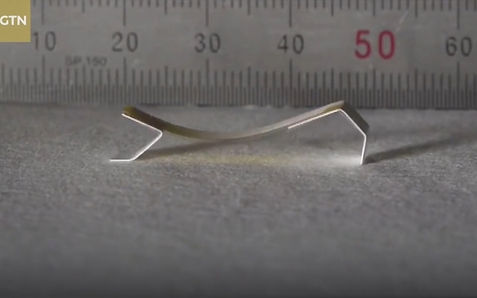
What's New
Japanese researchers develop ultrathin, highly elastic skin display
by University of Tokyo
A new ultrathin, elastic display that fits snugly on the skin can show the moving waveform of an electrocardiogram recorded by a breathable, on-skin electrode sensor. Combined with a wireless communication module, this integrated biomedical sensor system - called "skin electronics" - can transmit biometric data to the cloud.
This latest research by a Japanese academic-industrial collaboration, led by Professor Takao Someya at the University of Tokyo's Graduate School of Engineering, is slated for a news briefing and talk at the AAAS Annual Meeting in Austin, Texas on February 17th.
Thanks to advances in semiconductor technology, wearable devices can now monitor health by first measuring vital signs or taking an electrocardiogram, and then transmitting the data wirelessly to a smartphone. The readings or electrocardiogram waveforms can be displayed on the screen in real time, or sent to either the cloud or a memory device where the information is stored.
The newly-developed skin electronics system aims to go a step further by enhancing information accessibility for people such as the elderly or the infirm, who tend to have difficulty operating and obtaining data from existing devices and interfaces. It promises to help ease the strain on home healthcare systems in aging societies through continuous, non-invasive health monitoring and self-care at home.
The new integrated system combines a flexible, deformable display with a lightweight sensor composed of a breathable nanomesh electrode and wireless communication module. Medical data measured by the sensor, such as an electrocardiogram, can either be sent wirelessly to a smartphone for viewing or to the cloud for storage. In the latest research, the display showed a moving electrocardiogram waveform that was stored in memory.
The skin display, developed by a collaboration between researchers at the University of Tokyo's Graduate School of Engineering and Dai Nippon Printing (DNP), a leading Japanese printing company, consists of a 16 x 24 array of micro LEDs and stretchable wiring mounted on a rubber sheet.
Hygrobot: A self-locomotive ratcheted actuator powered by environmental humidity
By Science Robotics
Chinese CGTN introduced the ultra-small robot developed by a research team of Seoul National University called 'Hygrobot' . This robot is similar to the motion of an inchworm and is said to operate in a humid environment. The robots has a new concept that moves only in humidity without battery. The robot, which may be crawling like a snake, has also appeared on the online edition of Science Robotics, a worldwide academic journal.
Microrobots that are light and agile yet require no artificial power input can be widely used in medical, military, and industrial applications. As an actuation system to drive such robots, here we report a biologically inspired bilayer structure that harnesses the environmental humidity energy, with ratchets to rectify the motion. We named this actuator-ratchet system the hygrobot. The actuator uses a hygroscopically responsive film consisting of aligned nanofibers produced by directional electrospinning, which quickly swells and shrinks in lengthwise direction in response to the change of humidity. The ratchets based on asymmetric friction coefficients rectify oscillatory bending motion in a directional locomotion. We mathematically analyzed the mechanical response of the hygrobot, which allowed not only prediction of its performance but also the optimal design to maximize the locomotion speed given geometric and environmental constraints. The hygrobot sterilized a trail across an agar plate without any artificial energy supply.

